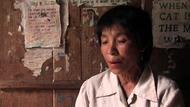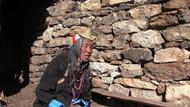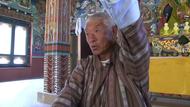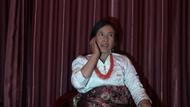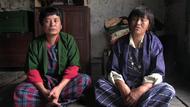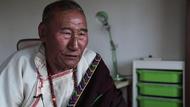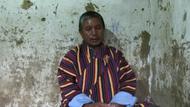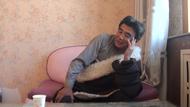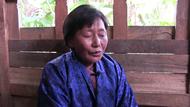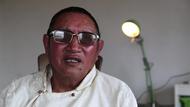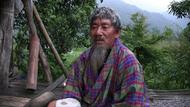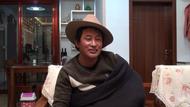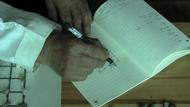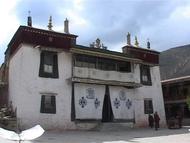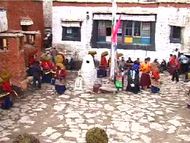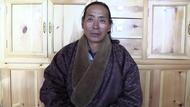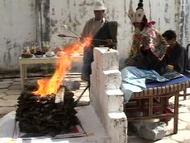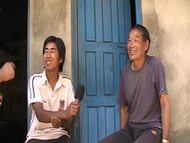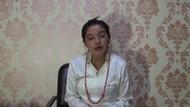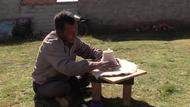Video Overview
A teacher guides his student through the tangka canvas preparation process.
- Lhasa
- ལྷ་བྲི་བ། Tangka Painterརས་འདི་ད་ལྟ་ང་ཚོས་ཁ་སང་མངགས་བཞག་པའི་འཇམ་དཔལ་དབྱངས་ཀྱི་ཐང་ཀ་བཟོ་ས་འདི་རེད། རས་གཞི་འདི་འཚེམ་ཚར་སོང་ན་ཡང་རྒྱང་སྒྲོམ་འདི་ལ་ཕར་སྦྱར་དགོས་ཀྱི་ཡོག་རེད།This is the cloth we ordered last time for the Manjuśri tangka. After stitching, we need to mount it on the frame.
- ལྷ་བྲི་བ། Tangka Painterལྟ་ང་ཚོ་འདི་གས་ཚང་མ་སྨྱུག་མའི་འདི་ལ་ཡང་འཚིམ་བུ་རེ་རེ་བྱས་བརྒྱབ་བྱས་རས་དཀར་པོ་འདི་ལ་འཚིམ། འཚིམ་ཚར་བའི་རྗེས་ཡང་འདི་གས་འདི་ལ་ཡར་ཡང་སྦྱར་དགོས་ཀྱི་ཡོག་རེད།We stitch the cloth to these bamboo sticks one by one and then attach it to the frame.
- ལྷ་བྲི་བ། Tangka Painterའདི་ང་ཚོའི་ཐང་ཀ་བཟོ་སའི་ཐང་སྒྲོམ་རེད།This is the frame we use for making tangka.
- ལྷ་བྲི་བ། Tangka Painterའདི་འདུག་ས་བྱས་ཚར་སོང་ན་ཨཱ་ནི་ཡང་འདི་གས་འདི་ལ་ཡང་བསྐྱར་འཚེམ་དགོས་ཀྱི་ཡོག་རེད།After stitching the cloth, you have to join it with the frame by stitching again.
- ལྷ་བྲི་བ། Tangka Painterའཚེམ་ཚར་སོང་ན་འདི་གས་འདི་ལ་དཀར་རག་བཏང་། ཡང་དབུར་ཏི་བརྒྱབ་བྱེད་དགོས་ཀྱི་རེད།Then you whitewash the surface and smoothen it.
- ལྷ་བྲི་བ། Tangka Painterའདི་གས་ཚར་ན་དབུར་ཏི་ཐེངས་མ་གསུམ་ཙམ་རྒྱག་དགོས་ཀྱི་ཡོག་རེད། འདི་གས་གང་ག་ཚར་ན་གཞི་ནས་འདིའི་སྒང་ལ་རི་མོ་བྲིས་བྱས་འགོ་ཚུགས་རྒྱུ་རེད་མ་གཏོགས་རས་དཀར་པོའི་སྟེང་ལ་ལམ་སང་འགོ་ཚུགས་ཡག་ཡོག་མ་རེད།You have to polish the surface at least three times. Only after the completion of all these steps can you start drawing on the prepared canvas, not directly on a white cloth.
- ལྷ་བྲི་བ། Tangka Painterརས་འདི་གས་གང་ག་བཟོས་ཚར་པ་དང་ང་ཚོ་འདིའི་སྒང་ལ་དབུར་ཏི་ཐེངས་མ་གསུམ་བརྒྱབ། ཚོན་དཀར་པོ་འདི་ཐེངས་མ་གསུམ་ཙམ་འདི་འདྲས་བཏང་དགོས་ཀྱི་ཡོག་རེད། འདི་བཏང་ཚར་སོང་ན། དབུར་ཏི་ཐེངས་མ་གསུམ་ཙམ་བརྒྱབ། གཞི་ནས་འདིའི་སྒང་ལ་རི་མོ་བྲིས་དགོས་ཀྱི་ཡོག་རེད།Whitewash it about three times and also iron it about three times. And then start your drawing on it.
- ལྷ་བྲི་བ། Tangka Painterའཚེམ་བུ་འདི་རྒྱག་ཡག་ལ་ཡང་གནད་འགག་ཆེན་པོ་ཞེ་དྲགས་ཡོག་རེད། ཡང་འཚེམ་བུ་ཞིག་རྒྱག་སྟངས། ཞེང་ཁ་ཆེ་ཆུང་ཆེན་པོ་ཞེ་དྲགས་བྱས་ན་རས་འདི་གཅིག་ཀྱོག་ཀྱོག་ཆགས་འགྲོ་ཡགThe stitching also has its tricks. You have to get the proportion right. If you leave big gaps between the stitching, the surface of the cloth will warp.
- ལྷ་བྲི་བ། Tangka Painterའདི་འདྲས་ཀྱི་ཡོག་རེད། ཁོ་ལ་དང་པོ་འཚེམ་བུ་རྒྱག་ཡོང་དུས་ནས་འཚེམ་བུ་གཅིག་ཕ་གིར་ཆ་སྙོམས་པོ་ཞེ་པོ་ཞིག་མ་བརྒྱབ་པ་ཡིན་ན།So if you fail to stitch it evenly right from the beginning,
- ལྷ་བྲི་བ། Tangka Painterཐང་ཀ་བྲིས་དུས་ཡང་གཅིག་ཐང་ཀ་ཀྱོག་ཀྱོག་ཆགས་འགྲོ་ཡག ཐང་ཀ་ཀྱོག་ཀྱོག་ཆགས་པ་ཡིན་ན། ཞུ་གུར་གོས་ཤམ་བཏང་ཚར་སོང་ན། གོས་ཤམ་འདི་ཡག་པོ་མ་ཆགས་པ་བྱས་འདི་འདྲ་སེ་ཀྱག་ཀྱོག་འདི་འདྲས་ཆགས་འགྲོ་གི་རེད། འོ་འདི་འདྲས་ཤིག་རེད་ཤགthen the tangka may get warped, which makes it harder when you frame it with decorative cloths later on, and the result won't be nice.
- ལྷ་བྲི་བ། Tangka Painterད་ལྟ་འདི་ངའི་དགེ་ཕྲུག་རེད། དགེ་ཕྲུག་བྱས་ལྟ་ད་ལྟ་ལོ་གཅིག་ཙམ་འགྲོ་གི་ཡོག་རེད། རི་མོ་བྲིས་ཡག་དེ་ད་ལྟ་བྲིས་ཡག་དེ་ལ་འདི་གས་འབྲི་གི་ཡོག་རེད་ལྟ།He has been my apprentice for the last year. Currently, he is learning how to draw these figures.
- ལྷ་བྲི་བ། Tangka Painterསྟོན་པའི་ཤ་གཙུག་དང་ནམ་བཟའ་སྒྲོན་པ། ཤ་གཙུག་ཐོན་པ་རེད། འདིའི་ཤ་གཙུག་རེད།He began by learning how to draw Buddha's figure, without clothing and with clothing. He completed the former.
- ལྷ་བྲི་བ། Tangka Painterང་ཚོས་དང་པོ་བྲིས་ཡག་དེ། དབུ་ལུས་བྲིས་དེ་ནས་ཡང་ཤ་གཙུག་བྲིས་དགོས་ཀྱི་ཡོག་རེད། འདི་བྲིས་ཚར་ནས་ད་ལྟ་ནམ་བཟའ་བྲིས་བྱས་ནམ་བཟའ་འདི་གྲས་གཅིག་ལ་སླེབས་བསྡད་ཡོག་རེད།First thing we draw is Buddha's head, and shatsuk, which means without any clothing.
- ལྷ་བྲི་བ། Tangka Painterརི་མོ་ད་ལྟ་སྦྱངས་བྱས་ལོ་གཅིག་ཙམ་འགྲོ་གི་ཡོག་རེད། ལོ་གཅིག་གི་ནང་ལོགས་ལ་ལྟ་འདི་གྲས་ཤིག་རི་མོ་བྲིས་ཡག་འདི་གྲས་ཤིག་ཆགས་བསྡད་ཡོག་རེད།He has been drawing these for the past year.
- ལྷ་བྲི་བ། Tangka Painterད་ལྟ་ང་ཚོ་འདིའི་སྒང་ལ་འཇམ་དཔལ་དབྱངས་གཅིག་བཟོ་ཡང་འདི་ནི་སྤྱིར་བཏང་གི་ང་ཚོ། འདིའི་ཞུ་གུ་ཡཱ་སྒྲོལ་ལྗང་ཞིག་བྲིས། དེའི་ཞུ་གུ་འདི་ལ་འཇམ་དཔལ་དབྱངས་འདི་འདྲས་འབྲི་སྟངས་སློབ་ཡག་འདི་འདྲས་རེད།Next figure he will learn to draw is Manjuśri and then Green Tara.
- ལྷ་བྲི་བ། Tangka Painterཁོ་རའི་གོ་རིམ་འདི་འདྲས་ཟེ་འགྲོ་དགོས་ཀྱི་ཡོག་རེད། དང་པོ་དང་པོ་སངས་རྒྱས་བཅོམ་ལྡན་འདས་ཀྱི་དབུ་ལུས་ཀྱི་ཐིག་བརྒྱག་སྟངས་དང་། དབུའི་འདི་ནས་ཡར་འབྲི་སྟངས་སློབ་ཀྱི་ཡོག་རེད།This is the order in which one learn to draw. You first master the measurements of the head.
- ལྷ་བྲི་བ། Tangka Painterའདི་ནས་ཞུ་གུ་འདིར་ཡར་ཤ་གཙུག་བྱས་ནམ་བཟའ་མེད་པ། ནམ་བཟའ་མེད་པ་འདི་འདྲས་བྱས་འདི་ནང་བཞིན་འདི་རེད། ལྟ་འདི་དང་གཅིག་པ་རེད། འདིར།Then you learn how to draw Buddha's body without clothing. Like these examples here.
- ལྷ་བྲི་བ། Tangka Painterའདི་ནམ་བཟའ་མེད་པ་དེ་རེད། གང་ལྟར་དང་པོ། དང་པོ་དབུ་ལུས་འདི་བྲིས། འདི་ནས་ཡང་འདིའི་ཞུ་གུ་འདིར་ཤ་གཙུག་འབྲི་དགོས་ཀྱི་ཡོག་རེད།This one is one without clothing.
- ལྷ་བྲི་བ། Tangka Painterའདི་བྲིས་ཚར་ནས་ཤ་གཙུག་འདི་ཡག་པོ་ཆགས་སོང་ན་འདི་ནས་ནམ་བཟའ་འདི་བྲིས་དགོས་ཀྱི་ཡོག་རེད་ཟེར།After you master drawing the naked figure, then you have to master the one with clothing.
- ལྷ་བྲི་བ། Tangka Painterད་ལྟ་འདི་གཉིས་བྲིས་པར་འདིར་གཅིག་ཉིན་ལྟར་རེ་ཞིག་འབྲི་གི་ཡོག་རེད། ཡིནའང་ད་དུང་ལོ་གཅིག་ཙམ་ནང་ལོགས་ལ་འོ་ལྟ་ནམ་བཟའ་འདི་འདྲས་གཅིག་ལ་སླེབས་བསྡད་ཡོག་རེད་ཟེར།To master these two drawings, you have to practice it on a daily basis. So he is in this phase now.
- ལྷ་བྲི་བ། Tangka Painterའཇམ་དཔལ་དབྱངས་བྲིས་ཡག་དེ་ད་དུང་ལས་འདིའི་ཞུ་གུར་སྐུ་སྒྲོལ་ལྗང་ཞིག་བྲིས་ཚར་སོང་ན། འདིའི་ཞུ་གུ་དེར་འཇམ་དཔལ་དབྱངས། དེ་ནས་སྤྱན་རས་གཟིགས། འདི་འདྲས་སེ་བྱས་བྱས་རིམ་པ་རིམ་པ་བྱས་བྱས་འབྲི་དགོས་ཀྱི་ཡོག་རེད་ཟེར། རི་མོ་འབྲི་སྟངས་དེ།After learning how to draw Manjuśri and Green Tara, then you start to learn how to draw Avalokiteśvara.
- ལྷ་བྲི་བ། Tangka Painterའཇམ་དཔལ་དབྱངས། སྤྱན་རས་གཟིགས། འདི་ཚོ་བྲིས་ཚར་སོང་ན་གཞི་ནས་ཕྱག་ན་རྡོ་རྗེ་དང་། ཆོས་རྒྱལ། མགོན་པོ། འདི་གྲས་ཀྱི་དྲག་པོའི་རི་མོ་འབྲི་སྟངས་འདི་འདྲས་བསླབ་ཀྱི་ཡོག་རེད་ཟེར།Then later you learn to draw more elaborate figures, such as Vajarapani, Dharma Kings, and Mahakala.
- ལྷ་བྲི་བ། Tangka Painterརི་མོ་ཁོ་ར་དང་པོ་འབྲི་དུས་ཙམ་ལ་བང་རིམ་བྱས་རིམ་པ་རིམ་པ་ཡོག་རེད། དེའི་འཇུག་ལ་རས་སྒང་ལ་ཚོན་གཏོང་སྟངས་སློབ་དགོས་ཀྱི་ཡོག་རེད།So when learning to draw, you have to follow this order of complexity. Then you learn how to apply colors.
- ལྷ་བྲི་བ། Tangka Painterགཞི་ནས་ཚོན་གཏོང་སྟངས་སློབ། ཞོར་ཞོར་ལ་དཔྱད་རྒྱག་སྟངས་འདི་གས་བྱས། མཚོན་གཏོང་སྟངས་ཡག་པོ་བྱུང་སོང་ན། གཞི་ནས་ཐང་པའི་རས་འདི་འདྲ་བཟོས་ཚར་སོང་ན་སོ་སོས་རི་མོ་བྲིས་བྱས་སོ་སོ་སྤྱིར་བཏང་གི་རང་མགོ་མཐོན་པ་དེ་འདྲ་ཞིག་རེད།While learning to draw, you also learn how to prepare framed canvas. After mastering all these, you began to learn how to use the colors. After that, you start to do all these without supervision, and that is how you became an independent and professional tangka painter.
- ལྷ་བྲི་བ། Tangka Painterཡིན་ནའི་ལས་ད་ལྟ་དཀའ་ལས་ཁག་པོ་རེད། རི་མོ་ཟེར་བ་དེ་གཏིང་ཟབ་པོ་ཞེ་དྲགས་རེད། ང་ཚོར་ཆ་བཞག་ནའི་རི་མོ་འདི་འདྲ་སྦྱོང་བར་ང་རང་ལོ་སུམ་བཅུ་སོ་གཅིག་རེད། ལོ་༡༢ཙམ་ནས་རི་མོ་སྦྱངས་པ་རེད།However, it is very hard. Tangka art is deep. In my case, right now I am 31 years old. I first started learning tangka painting when I was 12.
- ལྷ་བྲི་བ། Tangka Painterརི་མོ་སྦྱངས་ནས་གཙུག་ལག་ཁང་ནང་ལོགས་ལ་ང་ཚོས་ལས་ཀ་བྱས་ནས་ལོ་༨ཙམ་བསྡད་པ་རེད། After completion of my tangka painting studies, I worked in the Tsuklakhang temple for eight years.
- ལྷ་བྲི་བ། Tangka Painterལོ་༢༥ཙམ་ནས་སྤྱིར་བཏང་གི་སོ་སོ་རང་མགོ་ཐོན་པའི་བཟོ་ལྟ་བྱས་ནས་ཁང་པའི་ནང་ཐང་ཀ་བྲིས་བྱས། སོ་སོས་བྲིས། སོ་སོས་བཟོས། དགེ་ཕྲུག་གཅིག་ཀྱང་ཉར་བ་སོགས་བྱེད་ཀྱི་ཡོད།By the time when I was 25, I became an independent and professional tangka painter. I started my drawing, production of tangka, and also kept one apprentice.
- ལྷ་བྲི་བ། Tangka Painterང་ཚོའི་རྒན་ལགས་བཤགས་མཁན་ཚོ་སྔ་མོའི་ལོ་རྒྱུས་སྒང་གི་མི་འདི་འདྲ་རེད། ཁོང་རྣམ་པ་ཚོ་གང་ག་ལག་ཤེས་ཀྱི་ཐོག་པ་ཐོག་པ་མེད་པ་དང་། རི་མོ་དང་གང་སྤྱིའི་ཐད་ལ་ག་རེ་འབྲི་དགོས་ཀྱང་ཐོག་པ་མེད་པ་རེད།My late tangka teachers were all well-known Tibetan painters. They all were expert in their crafts, be it drawing or whatever.
- ལྷ་བྲི་བ། Tangka Painterང་ཚོ་གཙུག་ལག་ཁང་ནང་ལོགས་ལ་ལས་ཀ་ལོ་༨ཙམ་བྱས། ང་ཚོར་ཀྱང་རི་མོ་སློབ་སྟངས་ཀྱང་དགེ་རྒན་ད་ལྟའི་བང་རིམ་བཞིན་གཅིག་པ་གཅིག་རྐྱང་རེད། ད་ལྟ་ང་ཚོས་ཁོང་ཚོར་བསླབ་ཡག་གཅིག་པ་གཅིག་རྐྱང་རེད།We worked in the Tsuklakhang for eight years under their supervision and they taught us tangka painting in the same way I am currently teaching him.
- ལྷ་བྲི་བ། Tangka Painterདང་པོ་དབུ་ལུས་བྲིས། དེ་ནས་ཤ་གཙུག་བྲིས། དེ་ནས་ནམ་བཟའ་བྲིས། དེ་ནས་རྗེས་ལ་འཇམ་དཔལ་དབྱངས། སྤྱན་རས་གཟིགས་འདི་འདྲ་བྲིས། འོ་འདི་འདྲ་བྲིས་བྱས་གཞི་ནས་ཡང་རས་འདི་འདྲ་འཚིམ་སྟངས་སློབ་ཡགYou start with head, then learn to draw body without and the clothing. And then move on to draw Manjuśri, Avalokiteśvara, and so on.
- ལྷ་བྲི་བ། Tangka Painterཚོན་གཏོང་སྟངས་སློབ་ཡག དཔྱད་རྒྱག་སྟངས་སློབ་ཡག འདི་གས་གང་ག་ཚར་སོང་ན། ཞིབ་ཚགས་ཟེར་དུས། སོ་སོ་གང་ག་ཆ་ཚང་བཟོས་ཚར་ནས་སྤྱན་འབྱེད་བྱེད་ཡག་དང་གང་ག་སོ་སོས་ཤེས་སོང་ན། འདི་མིང་ལ་ཞིབ་ཚགས་ཟེར། གཞི་ནས་ཐང་ཀ་ཐོན་པའི་སྐད་ཆ་རེད།Then you master the coloring. In the final stage, one learn how to open the eyes of central figures in tangka. This called is zhibtsak and it is an indication that you have mastered tangka painting.
- ལྷ་བྲི་བ། Tangka Painterང་ཚོར་ཐང་ཀ་སློབ་པའི་སྐབས་སུ་ལོ་༡༢ཙམ་ནས་སྤྱིར་བཏང་གི་ལོ་༢༥ཙམ་བར་དུ་འདི་འདྲ་སེ་དགེ་རྒན་མཉམ་དུ་ལས་ཀ་བྱས་ནས་འདུག་སེ་བསྡད་པ་རེད།Generally, we start learning tankga painting around the age of 12 and study with masters until you are about 25.
- ལྷ་བྲི་བ། Tangka Painterའདི་ནས་སོ་སོ་རང་མགོ་ཐོན་པའི་བཟོ་ལྟ་བྱས། ཁང་པའི་ནང་རི་མོ་བྲིས། མིས་ཐང་ཀ་མངགས་པ་གང་ག་འདིར་ནང་ལ་བཟོས་བྱེད་ཀྱི་ཡོག་རེད། དགེ་ཕྲུག་གཅིག་ད་ལྟ་འདུག་སེ་བྱས་ནས་ཉར་བསྡད་ཡོད། འོ་འདི་འདྲ་སེ་ཡིན།After that I became independent and began a full-time professional tangka painter and starting receiving painting commissions from patrons. Currently I have one apprentice.
- ལྷ་བྲི་བ། Tangka Painterརས་འདིའི་སྟེང་དུ་དང་པོ་འཚིམ་དུས་ཡང་ལས་སླ་པོ་ཞེ་དྲགས་ཡོག་མ་རེད། ཁོ་ཡག་པོ་མ་བྱས་ན་གྲུ་བཞི་ཏག་ཏག་མ་བསྡད་པ་ཡིན་ན་ཐང་ཀ་ཀྱོག་ཀྱོག་ཆགས་འགྲོ་གི་རེད།This stitching part is not easy, you have to be careful with proportion.
- ལྷ་བྲི་བ། Tangka Painterདང་པོ་འཚིམ་དུས་ནས་ཁ་ཐུག་དགོས། ཁ་ཐུག་ཡག་པོ་མ་བྱུང་ན་རྗེས་ལ་ཐང་ཀ་བྲིས་ཚར་རྗེས་ཐང་ཀ་ཀྱོག་ཀྱོག་ཆགས་འགྲོ་གི་རེད།Right from the beginning of stitching, make sure the lines are straight. Otherwise when you finish the drawing, the surface won't be flat.
- ལྷ་བྲི་བ། Tangka Painterཐང་ཀ་གཅིག་བཟོ་དུས་ཙམ་ལ་མགོ་ནས་མར་ལས་ཀ་བྱེད་དུས་ལས་ཀ་རྙོག་ཁྲ་ཚ་པོ་ཞེ་དྲག་ཡོག་རེད། གང་ག་ཞིབ་ཚགས་པོ་དང་ཡག་པོ་མ་བྱུང་བ་ཡིན་ན། ཐང་ཀ་འདི་ཡག་པོ་ཡོང་གི་མ་རེད།So making a tangka involves lots of complicated tasks and you need to pay attention to the details. Otherwise, the result won't be good.
- ལྷ་བྲི་བ། Tangka Painterཕ་གིར་ཐང་ཀ་གཅིག་བྲིས་ཡོང་དུས་ནས་ཀྱོག་ཀྱོག་ཆགས་འགྲོ་ཡག ང་ཚོ་ད་ལྟ་བོད་རིགས་ཀྱི་བཤད་ཚུལ་བྱས་པ་ཡིན་ན། ཐང་ཀའི་རས་གཞི་བཟོས་ཚར་བ་ཁོ་ར་ནས་ང་ཚོས་འདིའི་སྒང་ལ་འཇམ་དཔལ་དབྱངས་ཀྱི་སྐུ་ཞིག་འབྲི་དགོས་ཀྱི་ཡོག་རེད།According to our Tibetan belief, after the canvas is ready, first you draw an image of the Manjuśri on it.
- ལྷ་བྲི་བ། Tangka Painterའཇམ་དཔལ་དབྱངས་ཕེབས་ཚར་བ་ཡིན་བསམས་ནས་བྲིས་པ་ཡིན་ན་སྐུ་འདི་དཔེ་མི་སྲིད་པའི་ཡག་པོ་ཆགས་ཀྱི་ཡོད་ཞེས་འདི་འདྲ་ཟེ་ང་ཚོའི་རྒན་ལགས་བཤགས་མཁན་ཁོང་རྣམ་པ་ཚོས་གསུངས་ཚུལ་ཡོད།If you consider that image as the real Manjuśri, we believe that the resulting tangka will be excellent.
- ལྷ་བྲི་བ། Tangka Painterདཀར་རག་འདི་ཡག་པོ་བྱས་མར་གཉིལ། པིང་ཚོད་རན་པོ་ཞིག་བླུགས། རྒྱབ་ལོགས་དེར་གཅིག་འབྱུག་ཤོགStir it properly and then add a right amount of the animal glue.
- དགེ་ཕྲུག Apprenticeལཱ་སེ།Okay.
- ལྷ་བྲི་བ། Tangka Painterསྔོན་ལ་ཕག་དོ་འདི་འཕུར་འཕུར་ཡག་པོ་བཏང་བྱས་རྒྱབ་ལོགས་འདིར་གཅིག་འབྱུགClean the brush first and then paint the back of canvas first.
- ལྷ་བྲི་བ། Tangka Painterའཇམ་པ་ཞིག་གཏོང་ཤོག རས་ཀྱི་ཨི་ཁུང་ཕར་བསུབ་བྱས།Paint a smooth one and cover all the holes in the cloth.
- ལྷ་བྲི་བ། Tangka Painterརྒྱབ་ལོགས་ལ། རྒྱབ་མདུན་མི་ནོར་བྱེད་དགོས།Paint on the back, do not mix up the back and the front of a canvas.
- དགེ་ཕྲུག Apprenticeལཱ་སེ།Okay.
- ལྷ་བྲི་བ། Tangka Painterའདིར་འབྱུག་ཚར་སོང་ན་ཕྱི་ལོགས་ལ་སྐམ་ནས་ཞོག དེ་ལྟར་ཏོག་ཙམ་རྗེས་ལ་མདུན་ལ་གཅིག་འབྱུག འཐེན་སྐོར་ཞིག་རྒྱོབ།After you finished brushing, let it dry outside and adjust the string a little.
- དགེ་ཕྲུག Apprenticeལཱ་སེ།Okay.
- ལྷ་བྲི་བ། Tangka Painterལྟ་ཕྱི་ལོགས་འདིར་སྐམ་ཤོགNow leave it outside to let it dry.
- ལྷ་བྲི་བ། Tangka Painterའཇམ་དཔལ། འདི་སྐམ་འདུག་གམJampel, is it dry now?
- དགེ་ཕྲུག ApprenticeའདུགYes.
- ལྷ་བྲི་བ། Tangka Painterའོ་ལྟ་རས་གཞི་ཡར་འཁྱེར་ཤོག་དང་།Please bring the canvas inside then.
- ལྷ་བྲི་བ། Tangka Painterའོ་ལྟ་མདུན་འདིར་གཅིག་ཐོང་། འཐེན་སྐོར་ཏིག་ཙམ་བརྒྱབ་དང་། ཤུགས་ཆེན་པོ་མ་བརྒྱབ་པ་བྱས།Now paint the front of the canvas and pull the string lightly.
- དགེ་ཕྲུག Apprenticeལཱ་སེ།Okay.
- ལྷ་བྲི་བ། Tangka Painterཤུགས་ཞེ་དྲགས་མ་རྒྱོབ། ཏིག་ཙམ་ལས་མ་འཐེན།Don't use too much force, pull it lightly.
- ལྷ་བྲི་བ། Tangka Painterལྟ་འདིར་སྐྱ་ཚག་ལས་ཡོད་མེད་ཉི་མའི་ཟེར་ལ་ལྟོས་དང་སྐྱ་ཚག་ལས་ཡོད་མེད་ཤེས་ཐུབ།Make sure there are no unpainted spots by checking holding the canvas against the sunlight, like this.
- ལྷ་བྲི་བ། Tangka Painterརྒྱབ་ལོགས་ལ་ཏིག་ཙམ་དགོས། འདིའི་དཀྱིལ་ལ་ཚོན་ཞེ་དྲགས་སླེབས་མི་འདུགYou need to apply little white paint on the back. Here, in the center, you need some more.
- ལྷ་བྲི་བ། Tangka Painterའོ་ལྟ་འགྲིག་གི་ཡོག་རེད། ལྟ་ཡང་གཅིག་སྐོམས།That's good. Let it dry one more time.
- དགེ་ཕྲུག Apprenticeལཱ་སེ།Yes.
- ལྷ་བྲི་བ། Tangka Painterལྟ་ཐང་ཀ་འདི་སྐམ་འདུག་ན་ཡར་འཁྱེར་ཤོག་དང་། Please bring the tangka inside if it is dry now.
- དགེ་ཕྲུག Apprenticeལཱ་སེ།Yes.
- ལྷ་བྲི་བ། Tangka Painterསྐམ་འདུག་གམ།Is it dry?
- དགེ་ཕྲུག Apprenticeསྐམ་འདུགYes.
- ལྷ་བྲི་བ། Tangka Painterཡར་ཁྱེར་ཤོག་དང་། ལྟ་ཡག་པོ་ཆགས་འདུག རས་གཞི་འབྱུག་ཚར་བ་དང་འདུག་སེ་ལྟོས་དང་གང་ག་སྐྱ་ཚག་འདོན་བསྡད་པ་ཡོད་ན་དབུར་ཏི་བརྒྱབ་དུས་དབུར་ཏི་ཐེབས་ཀྱི་མ་རེད།Bring it inside. Now it looks good. If there unpainted spots, then it will be less effective when you smooth the surface.
- དགེ་ཕྲུག Apprenticeལཱ་སེ།Okay.
- ལྷ་བྲི་བ། Tangka Painterལྟ་དབུར་ཏི་རྒྱབ་ཤོགYou can now polish the surface.
 Loading ...
Loading ... 




